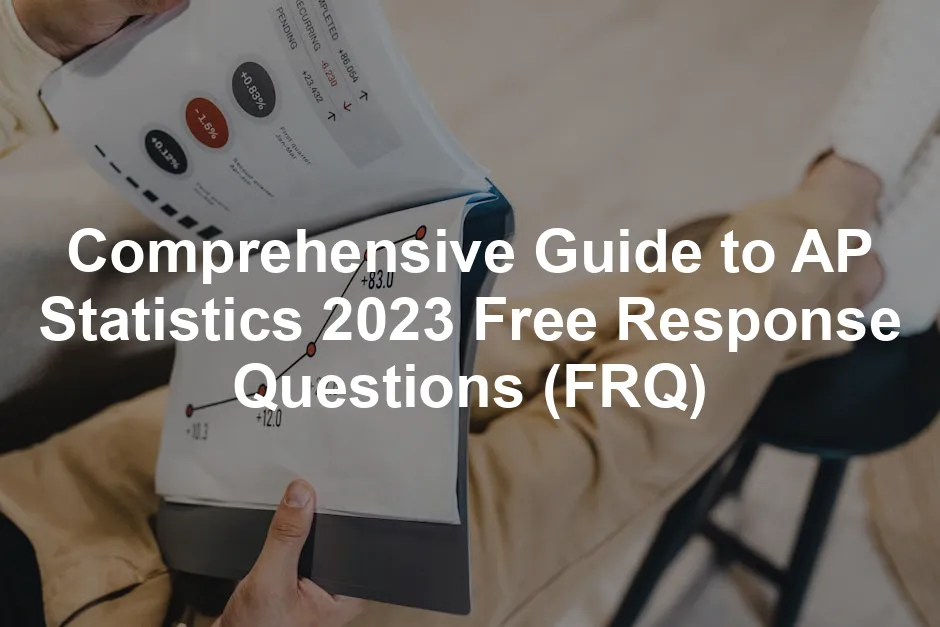Introduction
The AP Statistics exam is not just a test; it’s a rite of passage for high school students aiming for college success. This exam opens doors to advanced placement in college courses, potentially saving students time and money. Think of it as a golden ticket to the statistical world, where data reigns supreme!
At the heart of the AP Statistics exam are the Free Response Questions (FRQs). These questions assess students’ understanding of key statistical concepts through written explanations, calculations, and interpretations. Unlike multiple-choice questions, FRQs require students to articulate their reasoning and demonstrate their grasp of statistical methods, making them crucial for showcasing analytical skills.
For 2023, the FRQs introduced some interesting twists that may surprise seasoned test-takers. While some familiar topics appeared, the format and focus shifted slightly, reflecting the evolving nature of statistics education. This year’s exam emphasized writing conclusions for significance tests, a skill that proved vital in several questions. If you think you’ve seen it all, think again!
This article aims to provide a comprehensive look at the 2023 AP Statistics FRQs. We’ll break down the questions, offer solutions, and share tips that will be invaluable for future exam preparation. Whether you’re a student or a teacher, this guide will help you navigate the sometimes murky waters of statistics with confidence. Get ready to tackle those FRQs like a pro!

And speaking of confidence, why not pamper yourself after a long study session? Treat yourself to a set of Bath Fizzys for a relaxing soak that will rejuvenate your mind and body!
Understanding the 2023 AP Statistics FRQs
Overview of the Exam Format
The AP Statistics exam is structured into two sections: multiple-choice and free response. The FRQ section consists of six questions, each carrying its own weight in the overall score. This segment is designed to evaluate your ability to apply statistical concepts and procedures in real-world scenarios.
Students have a total of 90 minutes to complete the FRQs, which are divided into two parts. The first part typically includes simpler questions that test foundational knowledge, while the second part delves into more complex problems requiring deeper comprehension. The points are distributed based on the complexity of each question, with some questions being worth more than others.
Understanding the format is crucial. Students should practice time management to ensure they can address all questions thoroughly. Remember, it’s not just about getting the right answer; it’s about showing your work and explaining your reasoning clearly. This strategy often leads to partial credit, which can make a difference in your final score!
In summary, mastering the exam format is your ticket to success. Knowing what to expect will ease some of that pre-exam anxiety and allow you to focus on what really matters: demonstrating your statistical prowess.

Key Topics Covered in 2023
The 2023 AP Statistics Free Response Questions (FRQs) tackled some essential topics, pushing students to demonstrate their statistical skills in real-world contexts. Let’s break down the key themes that emerged this year.
Significance Tests
This year, significance tests took center stage, appearing in various forms across multiple questions. Students were required to articulate their conclusions clearly, which is vital in interpreting statistical results. For instance, one question prompted students to analyze data from Alaskan streams to determine if there were significant differences in fish populations. This question not only tested students’ understanding of the test’s mechanics but also their ability to communicate the implications of their findings effectively.

Regression Analysis
Regression analysis made a notable appearance, challenging students to interpret relationships between variables. In the Fiber Driveways FRQ, students had to analyze data to assess the impact of fiber types on durability. Students calculated regression coefficients and interpreted their significance, showcasing their grasp of how to model real-world phenomena with data. This skill is crucial, especially as more fields rely on data-driven decision-making.
Data Interpretation
Data interpretation was another prominent theme. Students were asked to draw conclusions from various datasets, requiring them to utilize charts, tables, and statistical outputs. The Bath Fizzys question included a dataset on customer preferences, where students needed to analyze trends and make recommendations based on their findings. This ability to interpret data is vital, as it mirrors the analytical skills needed in many professional settings today. For more insights on this topic, check out the article on inferential statistics vs descriptive statistics in data interpretation.
Understanding data interpretation is essential for students, as it reflects the real-world application of statistical skills. Learn more about this important topic.

In summary, the 2023 FRQs emphasized significance tests, regression analysis, and data interpretation. Students had to demonstrate not only their statistical knowledge but also their ability to articulate and apply that knowledge effectively in real-world contexts. This focus aligns perfectly with current trends in data analytics and emphasizes the importance of communication in statistics.
FRQ 3: Bath Fizzys
The Bath Fizzys question revolved around hypothesis testing, a fundamental concept in statistics. The prompt asked students to investigate whether the new fizzy bath product had a significant effect on user satisfaction compared to a traditional bath product.
To tackle this, students needed to set up their null hypothesis (H0) and alternative hypothesis (H1). The null hypothesis posited that there was no difference in satisfaction levels between the two products. In contrast, the alternative hypothesis claimed that the new product did improve satisfaction.
Students were required to conduct a significance test, often using a t-test or z-test depending on the sample size and standard deviation known. They calculated the test statistic and compared it to the critical value. If the test statistic exceeded the critical value, they would reject the null hypothesis.

After conducting the test, it was crucial to interpret the results meaningfully. Students needed to explain what their findings indicated about the bath fizzys. Did they truly enhance user satisfaction? A clear conclusion would not only summarize the statistical findings but also relate them back to the original research question, making the argument compelling.
Speaking of enhancing your bath experience, if you’re looking for a delightful way to unwind, consider a Bath Bomb Gift Set to elevate your relaxation game!
FRQ 4: Omega-3 Supplement
The Omega-3 Supplement question focused on the health benefits of Omega-3 fatty acids, asking students to analyze the effects of these supplements on heart health. Statistical knowledge required included understanding correlation, regression analysis, and confidence intervals.

Students were presented with a dataset of participants who regularly took Omega-3 supplements versus those who did not. A scatterplot could visually depict the relationship between Omega-3 intake and heart health metrics, such as cholesterol levels. Calculating the correlation coefficient would highlight the strength of this relationship.
The solution involved performing a linear regression analysis to determine how well Omega-3 intake predicted improvements in heart health. Additionally, students were expected to construct a confidence interval for the mean improvement in cholesterol levels. This interval provides a range of values within which the true mean likely falls, offering insight into the effectiveness of Omega-3 supplements.
Graphical representations, like scatterplots and regression lines, would enhance the analysis and help illustrate trends and relationships effectively.
If you’re looking to boost your heart health, don’t forget to check out some quality Omega-3 Supplements. They might just be the heart-healthy boost you need!
FRQ 5: Tule Elk
The Tule Elk FRQ required students to apply statistical concepts such as proportions and confidence intervals while analyzing elk population data. The question’s context centered on whether the population of Tule Elk had significantly increased over a certain period.

To approach this FRQ, students first needed to summarize the data. They could calculate the proportion of Tule Elk in the current year compared to previous years. This step set the stage for hypothesis testing, as students would establish a null hypothesis stating there was no increase in the population.
Next, they would calculate a confidence interval for the population proportion. This interval would help assess the uncertainty around the estimate. By comparing the current proportion to historical data, students could provide insights into whether the Tule Elk are thriving.
A detailed walkthrough would involve calculations, interpretations of the confidence interval, and contextualization of the results within broader ecological studies.
FRQ 6: Cleo Gold Necklaces
The Cleo Gold Necklaces question presented a scenario involving consumer preferences for different necklace styles. Key elements included analyzing a survey dataset to determine which style was most popular among consumers.

Students needed to summarize the data effectively, perhaps by calculating the mean and standard deviations of preferences for each style. This analysis would lead to the creation of a bar graph to visualize the popularity of each necklace type.
The solution also required addressing potential challenges, such as dealing with outliers or skewed data. Students might have faced difficulties in interpreting the results accurately. Overcoming these challenges involved applying appropriate statistical techniques, such as using median and interquartile range for better insights.
Ultimately, the conclusion would synthesize the findings, highlighting consumer trends and any implications for Cleo’s marketing strategies.
Common Mistakes and Misconceptions
When tackling Free Response Questions (FRQs) on the AP Statistics exam, students often stumble over common traps. The 2023 exam revealed several patterns in errors that can trip up even the most prepared test-takers. Let’s highlight these pitfalls and arm you with strategies to dodge them in the future.

Frequent Errors
One of the most significant errors observed in the 2023 FRQs was misapplying significance tests. Many students either chose the wrong test or miscalculated their test statistics. For instance, some used a t-test when a z-test was appropriate, leading to skewed results. This misstep occurred frequently in questions about Alaskan streams and regression analysis.
Another prevalent mistake involved neglecting to write clear conclusions. Students often provided calculations but failed to contextualize their findings. For example, in the Omega-3 supplement question, many outlined statistical procedures without linking back to the health implications. Remember, it’s not enough to crunch numbers; you need to convey what they mean!
Misconceptions About Statistical Methods
Misunderstandings about statistical methods can derail answers. A common misconception is that correlation implies causation. This myth can lead to incorrect assertions when interpreting data. In the Fiber Driveways FRQ, several students claimed that a stronger correlation between fiber type and durability implied one caused the other. That’s a big no-no! Always remember: correlation is a relationship, not a cause-and-effect statement.
Another misunderstanding involves confidence intervals. Some students mistakenly treated them as definitive statements rather than ranges of probable values. This confusion often surfaced in questions requiring data interpretation, especially with the Bath Fizzys prompt. A confidence interval indicates where the true parameter might lie, not where it definitely is.

Tips and Strategies to Avoid Pitfalls
To navigate these common mistakes, here are some actionable strategies:
- Practice with Purpose: Regularly work through past FRQs. Focus on identifying common themes and errors. Using resources like the Stats Medic website can provide valuable practice questions and solutions.
- Understand the Concepts: Instead of rote memorization, ensure you grasp the underlying concepts. This comprehension will help you choose the correct statistical methods and interpret results accurately.
- Show Your Work: Always write out your reasoning. Even if your calculations are wrong, showing your process can earn you partial credit. State your hypotheses clearly and summarize your findings in layman’s terms.
- Review Statistical Language: Familiarize yourself with the vocabulary of statistics. Knowing terms like “statistically significant” or “confidence level” can help you articulate your conclusions more effectively.
- Seek Feedback: Join study groups or engage with teachers to discuss your answers. Getting feedback on your reasoning can illuminate areas for improvement.
Tips for Success on AP Statistics FRQs
Preparation Strategies
Success on the AP Statistics FRQs doesn’t just happen overnight. It takes dedication, preparation, and the right strategies. Here are some tried-and-true methods to help you ace those tricky questions.

- Practice Exams: One of the most effective ways to prepare is through practice exams. These simulate the test environment and help you become familiar with the format. Consider using resources from the College Board or online platforms like Stats Medic for authentic FRQs.
- Review Sessions: Organize group study sessions with classmates. Explaining concepts to others reinforces your understanding. Plus, you can tackle difficult topics together, making the learning process more enjoyable!
- Textbooks and Online Courses: Invest time in reliable textbooks and online courses. Sites like Khan Academy offer excellent resources tailored to AP Statistics. Video lessons can clarify complex concepts quickly.
- Flashcards for Key Concepts: Create flashcards for important statistical terms and formulas. This method is perfect for quick reviews and helps reinforce your memory.
- Utilize Study Groups: Find a study group or an online forum where you can discuss concepts and solve problems collaboratively. Engaging with others can expose you to different perspectives and problem-solving approaches.
In summary, a mix of practice, collaboration, and leveraging quality resources will set you up for success. With these strategies in your toolkit, you’ll walk into the exam room with confidence, ready to tackle those FRQs!
Speaking of resources, don’t forget to grab a AP Statistics Exam Prep Book to guide your study sessions!
Test-Taking Strategies
When tackling Free Response Questions (FRQs) on the AP Statistics exam, a solid strategy can make all the difference. Here are some helpful tips to navigate those tricky questions successfully.
- Time Management is Key: First things first: time is not on your side. With 90 minutes to answer six FRQs, managing your time wisely is crucial. Aim to spend about 15 minutes on each question, leaving some room for review. If you feel stuck, don’t dwell! Move on, and come back later if time permits. This way, you maximize your chances of scoring points across all questions.
- Read the Prompts Carefully: Before you even think about writing, take a moment to read the question thoroughly. Pay attention to what the prompt asks. Are you being asked to interpret results, conduct a hypothesis test, or calculate a specific statistic? Understanding the question is half the battle. Misinterpreting the prompt can lead to wasted time and incorrect answers.
- Show Your Work: In the world of statistics, the journey is just as important as the destination. Clearly showing your work can earn you valuable partial credit, even if your final answer isn’t spot on. Write out your calculations, explain your reasoning, and don’t skip any steps. This approach not only helps your grader understand your thought process but also demonstrates your mastery of statistical concepts.
- Clear Communication is Essential: Remember, you’re not just solving equations; you’re telling a story. Write your conclusions in clear, concise language. A well-articulated conclusion connects your findings back to the question asked. Use phrases like “Therefore, we conclude that…” to summarize your results effectively. A little clarity can go a long way!
- Practice Makes Perfect: Finally, practice is your best friend. Work through past FRQs to familiarize yourself with the format and types of questions commonly asked. The more you practice, the more comfortable you’ll become with the exam’s rhythm. Plus, you’ll identify areas that need improvement, allowing for targeted study.

In summary, effective test-taking strategies hinge on time management, careful reading, showing your work, and clear communication. With these tactics, you’ll tackle the AP Statistics FRQs like a seasoned pro!
Conclusion
Mastering Free Response Questions (FRQs) is essential for success in AP Statistics. These questions not only showcase your understanding of statistical concepts but also highlight your ability to apply them to real-world scenarios. As we’ve seen, clear communication, time management, and showing your work are crucial elements in achieving a high score.
Reflecting on the insights shared in this article, it’s clear that preparation is key. Students should embrace the practices discussed to enhance their exam readiness. Regularly working through past FRQs, understanding the concepts behind statistical methods, and practicing clear communication can significantly improve performance.

Moreover, don’t shy away from seeking help. Whether it’s through study groups, tutoring, or online resources, collaboration can illuminate complex concepts and foster a deeper understanding. Remember, it’s perfectly okay to ask for assistance when grappling with challenging statistical ideas.
Lastly, continuous practice is vital. Statistics is a subject where familiarity breeds confidence. The more you engage with the material, the more adept you’ll become at tackling difficult problems. Aim to practice under timed conditions to simulate the exam environment.
In conclusion, mastering FRQs is not just about memorizing formulas; it’s about developing a comprehensive understanding of statistical concepts and their applications. With dedication and the right strategies, you can navigate the AP Statistics exam with confidence. So roll up your sleeves, dive into practice, and prepare to ace those FRQs!
FAQs
What are the most important topics to study for the AP Statistics FRQs?
When preparing for the AP Statistics FRQs, focus on several key areas that consistently appear in the exam. First, significance tests are fundamental, so be sure to understand hypothesis testing, p-values, and confidence intervals. Next, regression analysis is crucial for interpreting relationships between variables. Familiarize yourself with slope interpretations and correlation coefficients. Finally, data interpretation is vital; practice analyzing charts, graphs, and tables to draw conclusions.
How can I effectively prepare for the AP Statistics exam?
To effectively prepare for the AP Statistics exam, establish a structured study schedule. Start with a comprehensive review of the concepts covered in class. Use resources like textbooks, online courses, and practice exams to reinforce your understanding. Incorporate regular practice with past FRQs to build familiarity with the exam format. Additionally, join study groups or online forums to discuss challenging topics and clarify doubts with peers.
What should I do if I struggle with certain statistical concepts?
If you find yourself struggling with specific statistical concepts, don’t hesitate to seek help. Consider tutoring options, either in-person or online, to receive personalized assistance. Additionally, leverage resources like Khan Academy or YouTube for visual explanations of complex topics. Practice is also crucial; engage with problems that challenge you and enhance your understanding through repetition.
Are there any changes in the AP Statistics exam format for 2024?
As of now, the College Board has indicated no major changes to the AP Statistics exam format for 2024. However, it’s always wise to stay updated on any announcements or modifications. Keep an eye on the College Board’s official website for the latest information, as they sometimes implement minor adjustments to the exam structure or content focus. Staying informed will ensure you’re adequately prepared for any shifts in the exam landscape.
Please let us know what you think about our content by leaving a comment down below!
Thank you for reading till here 🙂
And if you’re a statistics enthusiast, you might find the Statistical Software for Data Analysis incredibly useful as you delve deeper into data exploration!
And for those who might be interested in a little something different, check out this adorable Tule Elk Plush Toy to add a bit of whimsy to your study space!
All images from Pexels




